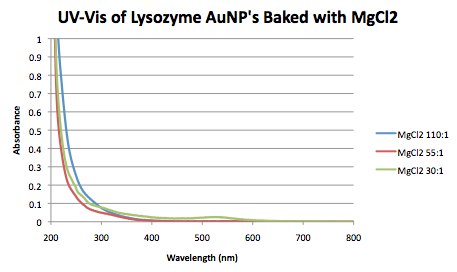Objective
- Spin down samples of 30:1 lysozyme-AuNP with 1M salts added and run UV-Vis.
- Heat samples 30:1 lysozyme-AuNP with 1M salts at 37°C overnight.
- Image results of 30:1, 55:1, and 110:1 lysozyme-AuNPs synthesized with salt added before heating using UV-Vis.
- Run atomic absorption of 30:1, 55:1, and 110:1 lysozyme-AuNPs synthesized with salts added before heating.
Procedure
Atomic Absorption
Creating the Gold Stock Solutions
- Add 50 μL of HAuCl4·3H2O and 4950 μL of distilled water to a Falcon tube, for a final concentration of 10 μg/mL Au.
- Add 100 μL of HAuCl4·3H2O and 4900 μL of distilled water to a Falcon tube, for a final concentration of 20 μg/mL Au.
- Add 150 μL of HAuCl4·3H2O and 4850 μL of distilled water to a Falcon tube, for a final concentration of 30 μg/mL Au.
- Add 200 μL of HAuCl4·3H2O and 4800 μL of distilled water to a Falcon tube, for a final concentration of 40 μg/mL Au.
- Add 250 μL of HAuCl4·3H2O and 4750 μL of distilled water to a Falcon tube, for a final concentration of 50 μg/mL Au.
Atomic Absorption Samples
Solutions with the following Au:lysozyme ratio were run on the AA:
- 30:1 MgCl2, CaCl2, NaCl, KCl
- 55:1 MgCl2, CaCl2, NaCl, KCl
- 110:1 MgCl2, CaCl2, NaCl, KCl
Images
Atomic Absorance of Lysozyme with KCl, NaCl, CaCl2, MgCl2
Figure 1. Gold:protein Ratio to Concentration of Lysozyme-AuNP Baked with Salts

UV-Vis
UV-Vis For Solutions that Contained Salt Before Lysozyme AuNP Synthesis




UV-Vis For Select Variables at More Refined Concentrations
- Please Note that the Control Wasn't Diluted With Variable Like the Other Samples.







- Based off of all UV-Vis data: The ABS for the controls were corrected for the dilution factor present and the percent AuNP's in solution was calculated.

Notes

- These results detail the samples from last Thursday with the addition of the variables to 1 mL aliquots of 30:1 ratio with salts added after.

- These results detail the reaction of the different ratios synthesized with salts added before heating.
|
 Biomaterials Design Lab: Spring 2014
Biomaterials Design Lab: Spring 2014














